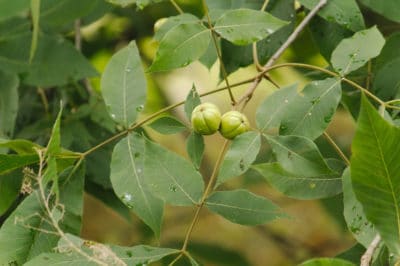Hickory Leaf Structure
Every hickory tree has compound leaves. They’re made up of a long central stem, or rachis. At the end of the stem are large terminal leaflets; the smaller lateral ones alternate along the stem. Because they’re arranged this way and their leaflets always occur in odd numbers, hickory leaves are termed ”odd pinnately compound” leaves.
Number, Size and of Hickory Leaflets
The shape and number of its leaflets provide great clues to a hickory tree’s identity:
- The bitternut hickory (Carya cordiformis) leaf has five to nine oval or lance-shaped leaflets. They measure 3 to 6 inches long and 3/4 to 2 1/2 inches wide.
- The shagbark hickory (Carya ovata) leaf has five to seven elliptical to oblong leaflets measuring 4 to 6 inches long and 1/2 to 2 1/2 inches wide.
- The shellbark hickory (Carya laciniosa) leaf has seven (rarely five or nine) oblong, pointed leaflets measuring 4 to 10 inches long.
- The pecan hickory (Carya illinoinensis)leaf has anywhere from nine to 17 pointed, oblong leaflets. They measure 4 to 7 inches long and 1 to 3 inches wide.
- The pignut hickory (Carya glabra) leaf has five to seven oval, narrow-based leaflets. They measure 3 to 6 1/2 inches long and 1 to 2 inches wide, with the terminal leaflets twice the size of the lowest ones.
Expert gardener’s tip: To remove the guesswork from hickory leaf identification, use color photos from a field guide to the hickory trees in your area.
Feeding the Tree
During spring and summer, hickory tree leaves contain a green, light-absorbing pigment called chlorophyll. Chlorophyll molecules are attached to disc-shaped chloroplasts. They pull water from the roots and carbon dioxide from the air and use light energy from the chlorophyll to convert them into starches and sugars. These are the foods the trees use to grow, flower and produce nuts.
Seasonal Color Change
Summer’s warm temperatures and long daylight hours allow hickory leaves to replace their chlorophyll as it breaks down. When the days cool and shorten, the chlorophyll fades to reveal the golden-yellow carotene molecules beneath it. The change usually occurs between mid September and late October, depending on where in USDA zones 4 through 9a hickory tree grows.
Feeding the Ecosystem
In addition to feeding the trees, hickory leaves feed their surrounding ecosystem. By generating fuel for nut production, they indirectly feed a host of wild animals including:
- Fox, red, flying and gray squirrels
- Eastern chipmunks
- Raccoons
- Black bears
- White-footed mice
Hickory Leaves, Bugs and Birds
Woodpeckers, wild turkeys, crows, blue jays and pheasants also snack on hickory nuts. But the real bird-feeding action results when moths and butterflies visit the trees and lay eggs which hatch into leaf-munching caterpillars.
Gypsy moth caterpillars, in particular, are a serious hickory tree pest. Fortunately, blue jays, towhees, cuckoos and orioles all feed on gypsy moths while chickadees eat their eggs. Small rodents — including mites, voles and shrews — eat the caterpillars that drop to the ground while squirrels, chipmunks, scouts and raccoons eat the pupating ones.
Birds with especially large appetites have their dreams realized in harmless hickory horned devil caterpillars. These green and orange, canopy-dwelling monsters eventually reach 6 inches long. While crawling down the trunks to pupate in the soil, they’re fair game for any bird not terrified by their curving, orange and black horns and ferocious-looking faces.
Feeding the Soil
When they drop in fall, hickory tree leaves become food for earthworms, ants, mites and other soil dwellers. After these larger creatures are through fragmenting them, fungi and bacteria take over and decompose what’s left into organic matter and mineralized soil nutrients. Both are essential for the health of the soil and everything that grows in it.
Expert gardener’s tip: Because they’re composed mainly of simple cellulose molecules, hickory leaves break down in about 10 weeks. Their stems, however, are made of tougher lignin. They need up to seven months to decompose completely.
